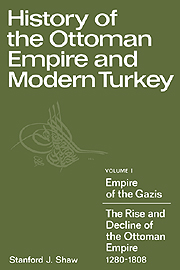Book contents
- Frontmatter
- Contents
- Preface
- Abbreviations
- Note on Pronunciation
- Map of the Growth of the Ottoman Empire to 1683
- Part One Rise of the Ottoman Empire, 1280–1566
- 1 The Turks in History
- 2 The First Ottoman Empire, 1280–1413
- 3 Restoration of the Ottoman Empire, 1413–1451
- 4 The Apogee of Ottoman Power, 1451–1566
- 5 The Dynamics of Ottoman Society and Administration
- Part Two Decentralization and Traditional Reform in Response to Challenge
- Map of the Decline of the Ottoman Empire, 1683–1924
- Bibliography: Ottoman History to 1808
- Index
4 - The Apogee of Ottoman Power, 1451–1566
Published online by Cambridge University Press: 02 February 2010
- Frontmatter
- Contents
- Preface
- Abbreviations
- Note on Pronunciation
- Map of the Growth of the Ottoman Empire to 1683
- Part One Rise of the Ottoman Empire, 1280–1566
- 1 The Turks in History
- 2 The First Ottoman Empire, 1280–1413
- 3 Restoration of the Ottoman Empire, 1413–1451
- 4 The Apogee of Ottoman Power, 1451–1566
- 5 The Dynamics of Ottoman Society and Administration
- Part Two Decentralization and Traditional Reform in Response to Challenge
- Map of the Decline of the Ottoman Empire, 1683–1924
- Bibliography: Ottoman History to 1808
- Index
Summary
With the rise of Mehmet II, called “the Conqueror” (Fatih), the Ottomans began a new era of conquest that extended the empire's rule across the Danube and into central Europe as well as over the lands of the Islamic caliphates in the Middle East and through much of North Africa.
Conquest of a New Empire: The Reign of Mehmet II, 1451–1481
Upon his accession on February 18, 1451, Mehmet inherited an empire in far better condition than that which his father had come to rule three decades before. He was free to take the initiative without having to satisfy either internal or external pressures. It appears, however, that soon after his accession Mehmet and his principal advisers, Şahabeddin şahin Paşa and Zaganos Paşa, decided that they needed a spectacular victory to fortify their political position against the Turkish nobility, which still wanted peace in order to prevent the kapikulu and devşirme from using new conquests to build their power. Nothing could be more spectacular than the conquest of Constantinople. Arguing with some justice that Byzantium had sheltered Muslim claimants to the Ottoman throne to foment discord in the empire, Mehmet felt that as long as Byzantium held out, there would always be the possibility of new Crusade efforts to rescue it and complete unification of the empire would be impossible. Beyond these practical considerations there was the dream of establishing a world empire, with Constantinople as its natural center. For centuries Muslim hopes of world domination had been associated with the capture of the Byzantine capital.
- Type
- Chapter
- Information
- History of the Ottoman Empire and Modern Turkey , pp. 55 - 111Publisher: Cambridge University PressPrint publication year: 1976

